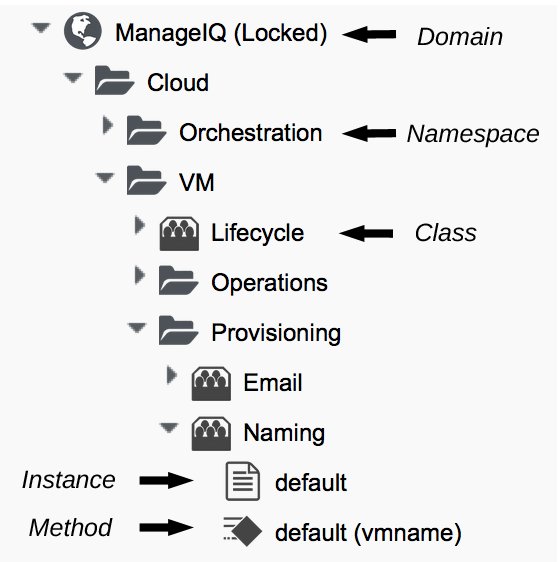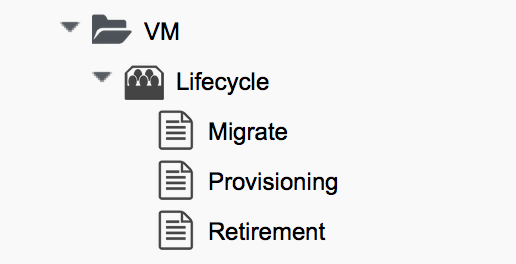
Introduction to the Automate Datastore
When we use the Automate capability of CloudForms/ManageIQ, we write scripts in the Ruby language, and use objects that the Automation Engine makes available to us. The CloudForms/ManageIQ Web User Interface (WebUI) allows us to access the Automate functionality via the Automate top-level menu (see Automate top-level menu for CloudForms 4.1).

The Automate Explorer
The first menu item that we see takes us to the Explorer. This is our visual interface into the Automate Datastore, and it contains the various kinds of Automate objects that we’ll use throughout this book (see Automate Explorer).

Before we start our journey into learning CloudForms/ManageIQ Automate, we’ll take a tour of the Automate Datastore to familiarise ourselves with the objects that we’ll find there.
The Automate Datastore
The Automate Datastore has a directory-like structure, consisting of several types of organisational unit arranged in a hierarchy (see Automate datastore icon styles).

We can look at each of these types of object in more detail.
Domains
A domain is a collection of namespaces, classes, instances and methods. The ManageIQ project provides a single ManageIQ domain for all supplied automation code, whilst Red Hat adds the supplemental RedHat domain containing added-value code for the CloudForms product. The ManageIQ and RedHat domains are locked, indicating their read-only nature, however we can create new domains for our own custom automation code. Automate Explorer shows the default domains, and an additional two custom domains: Bit63 and ACME.
Organising our own code into custom domains greatly simplifies the task of exporting and importing code (simplifying code portability and reuse). It also leaves Red Hat or the ManageIQ project free to update the locked domain through minor releases without fear of overwriting our customisations.
|
Note
|
If we are logged into CloudForms/ManageIQ as an account in a child tenant, we may see domains created by a parent tenant in the Automate Datastore, but they will also appear as locked. |
Domain Priority
User-added domains can be individually enabled or disabled, and can be ordered by priority such that if code exists in the same path in multiple domains (for example /Cloud/VM/Provisioning/StateMachines), the code in the highest priority enabled domain will be executed. We can change the priority order of our user-added domains using the Configuration → Edit Priority Order of Domains menu (see Editing the priority order of domains).

Importing and Exporting Domains
We can export domains using rake from the command line, and import them either using rake or from the WebUI. (Using rake enables us to specify more import and export options). A typical rake import line is as follows:
bin/rake evm:automate:import YAML_FILE=bit63.yaml IMPORT_AS=Bit63 SYSTEM=false \ ENABLED=true DOMAIN=Export PREVIEW=false
Copying Objects Between Domains
We frequently need to customise code in one of the the locked domains, for example when implementing our own custom VM Placement method. Fortunately we can easily copy any object from a locked domain into our own, using Configuration → Copy this … (see Copying a class).

When we copy an object such as a class, we are prompted for the From and To domains. We can optionally deselect Copy to same path and specify our own destination path for the object (see Specifying the destination domain and path).

Importing Old Format Exports
Domains were a new feature of the Automate Datastore in CloudForms 3.1/ManageIQ Anand. Prior to this release all factory-supplied and user-created automation code was contained in a common structure, which made updates difficult when any user-added code was introduced (the user-supplied modifications needed exporting and reimporting/merging whenever an automation update was released).
To import a Datastore backup from a CloudForms 3.0 and prior format Datastore, we must convert it to the new Datastore format first, like so:
cd /var/www/miq/vmdb bin/rake evm:automate:convert FILE=database.xml DOMAIN=SAMPLE \ ZIP_FILE=/tmp/sample_converted.zip
Namespaces
A namespace is a folder-like container for classes, instances and methods, and is used purely for organisational purposes. We create namespaces to arrange our code logically and namespaces often contain other namespaces (see Namespaces).

Classes
A class is similar to a template, it contains a generic definition for a set of automation operations. Each class has a schema, that defines the variables, states, relationships or methods that instances of the class will use.
|
Note
|
The Automate Datastore uses object-oriented terminology for these objects. A class is a generic definition for a set of automation operations, and these classes are instantiated as specific instances. The classes that we work with in the Automate Datastore are not the same as Ruby classes that we work with in our automation scripts. |
Schemas
A schema is made up of a number of elements, or fields, that describe the properties of the class. A schema often has just one entry - to run a single method - but in many cases it has several components. A more complex schema shows the schema for a placement class, which has several different field types.

Adding or Editing a Schema
We add or edit each schema field in the schema editor by specifying the Type from a drop-down list (see Schema field type).

Each field type has an associated Data Type which is also selectable from a drop-down list (see Schema field data type).

We can define default values for fields in a class schema. These will be inherited by all instances created from the class, but can be optionally overridden in the schema of any particular instance.
Relationships
One of the schema field types is a relationship, which links to other instances elsewhere in the Automate Datastore. We often use relationships as a way of chaining instances together, and relationship values can accept variable substitutions for flexibility (see Relationship fields showing variable substitutions).

Instances
An instance is a specific instantiation or "clone" of the generic class, and is the entity run by the Automation Engine. An instance contains a copy of the class schema but with actual values of the fields filled in (see Single class definition with three instances).

Methods
A method is a self-contained block of Ruby code that gets executed when we run any automation operation. A typical method looks like this:
###################################################################
#
# Description: select the cloud network
# Default availability zone is provided by Openstack
#
###################################################################
# Get variables
prov = $evm.root["miq_provision"]
image = prov.vm_template
raise "Image not specified" if image.nil?
if prov.get_option(:cloud_network).nil?
cloud_network = prov.eligible_cloud_networks.first
if cloud_network
prov.set_cloud_network(cloud_network)
$evm.log("info", "Image=[#{image.name}] Cloud Network=[#{cloud_network.name}]")
end
endMethods can have one of three Location values: inline, builtin, or URI. In practice most of the methods that we create are inline methods, which means they run as a separate Ruby process outside of Rails.
Summary
In this chapter we’ve learned about the fundamental objects or organisational units that we work with in the Automate Datastore: domains, namespaces, classes, instances and methods.
We are now ready to use this information to write our first automation script.